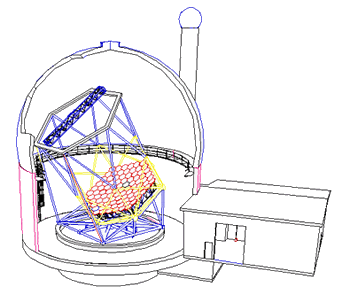
OVERVIEW
- First public presentation about what became the HET concept was a talk by
Dan Weedman of PSU in 1984
- Telescope budget: $13.5M US
- Ground breaking: March 25, 1994
- First Light: December 10, 1996
- First spectrum (using 21 mirrors): early September 1997
- HET is operated by on-site staff of 4 Engineers, 3 Telescope
Operators, 3 Observer/Astronomers, Facility Manager, Administrative
Assistant, and 3-4 technical staff of McDonald Observatory
- 25 computers to run telescope and instrumentation
- Telescope Operator responsible for telescope safety, driving, and make
call on closing
- Resident Astronomer responsible for navigation what/where/when and
quality control
- Total weight of telescope (main structure, mirror truss, mirrors,
tracker) = 80 tons
DOME
- Diameter = 86 feet
- Total Weight = 65 tons
- Shutter Weight = 6.9 tons
- Reflective covering (aluminum) = 7 tons
- Rotation drive is two rubber wheels pushing against a steel ring
TELESCOPE STRUCTURE
- Weight = 48 tons
- "Floats" on 8 air bearings, each with a capacity of 10 tons
- Each air bearing has 25-30 psi
- Rotation can reposition the azimuth to about 0.002 degrees
- Travel Range: ± 230°
- Velocity: 3.0°/sec
- Acceleration: 0.5°/sec2
- Position Resolution: ± 1 arc sec
- Position Measurement Accuracy: 2.5 arc sec (0.00068°)
- Display Resolution: 0.001°
- Feedback Resolution: 0.00017°
- Operating Temperature: -20° to +125°F (-30° to 50°C)
- Number of Motors: 2
- Motor Horsepower, HP: 2.7
- Motor Base Speed, RPM: 1500
PRIMARY TRUSS
- 1747 struts
- 389 nodes
- Weight = 12 tons
- 52 temperature sensors
TELESCOPE TRACKER
- Weight = about 8 tons
- Payload = 2,200 lbs
- It takes simultaneous motions of 10 motors to follow a star
- 6 degrees of motion (x,y,z, phi, rho, theta)
- +/- 8 degrees range of movement
- Instrument adapter (Prime Focus Instrument Platform = PFIP) includes
an optical corrector made up of four mirrors, so light from stars actually uses 5 mirrors
MIRRORS
- 91 identical 1 meter hexagonal segments made of Schott "Zerodur"
(Coefficient of expansion 1.5E-07 /degreeC)
- 5 spare mirror segments
used during re-coating of original segments
- Fixed elevation angle = 55 degrees
- Radius of curvature = 26.165 meters; all mirrors match this to 0.5mm
- Each segment is 1000mm across (flat-to-flat), 52mm thick
- Each mirror weighs about 250 pounds
- Weight of 91 mirrors plus support frames = 13 tons
- Primary Mirror array = 11.1 meters (36.4 ft) by 9.8 meters (32.2
ft)
- Total area of the primary array = 78 square meters
- Gaps between mirrors lose 2.04% of potential reflecting area
- Mirror steps of about 1/3 wavelength of light (193 Angstroms or
.0193 microns)
- Focal length of mirror: 13 meters or F 1.3
- Mirror segments moved by actuators (stepping motors)
- 3 actuators/mirror = 273 total
- Actuators: screw shafts with 35 threads/inch; ratio of actuators is
485 turns of motor = 1 turn of shaft; 1 step = 280nm
- Cleaning primary mirrors: once per month with CO2
- Original mirror coating is being stripped and surface aluminized
MIRROR ALIGNMENT
SAMS (Segment Alignment Maintenance System)
- 12 sensors/ mirror except edge segments – 480 sensors total
- Active sensor on one segment, passive sensor on neighboring segment
and a resonant frequency is created between segments
- Segment shift
is measured by quantifying change in resonance between segments
- SAMS segment corrections once per minute
MARS (Mirror Alignment Recovery System)
- Shack/Hartmann detector measures focus of one segment and then sets sphere
on that reference mirror
- Laser sent to entire array to measure positions
and make corrections
- Used once at beginning of night operations
SPECTROGRAPHS
- Able to view wavelengths from .4nm to 1 micron
- Wavefront = 500nm
- LRS (Low Resolution)– 23rd limiting magnitude, 3Kx1K CCD chip
- MRS (Medium Resolution)– not completed yet 4Kx4K CCD chip
- HRS
(High Resolution) – 19th limiting magnitude, 4Kx4K CCD chip
|


